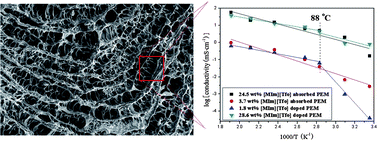High-temperature proton exchange membranes from ionic liquid absorbed/doped superabsorbents†
Abstract
The development of high-temperature

* Corresponding authors
a
Institute of Materials Physical Chemistry, Huaqiao University, Quanzhou 362021, China
E-mail:
jhwu@hqu.edu.cn, tangqunwei@hotmail.com
Fax: +86-595-22693999
Tel: +86-595-22693899
The development of high-temperature

 Please wait while we load your content...
Something went wrong. Try again?
Please wait while we load your content...
Something went wrong. Try again?
Q. Tang, J. Wu, Z. Tang, Y. Li and J. Lin, J. Mater. Chem., 2012, 22, 15836 DOI: 10.1039/C2JM32637J
To request permission to reproduce material from this article, please go to the Copyright Clearance Center request page.
If you are an author contributing to an RSC publication, you do not need to request permission provided correct acknowledgement is given.
If you are the author of this article, you do not need to request permission to reproduce figures and diagrams provided correct acknowledgement is given. If you want to reproduce the whole article in a third-party publication (excluding your thesis/dissertation for which permission is not required) please go to the Copyright Clearance Center request page.
Read more about how to correctly acknowledge RSC content.
 Fetching data from CrossRef.
Fetching data from CrossRef.
This may take some time to load.
Loading related content
